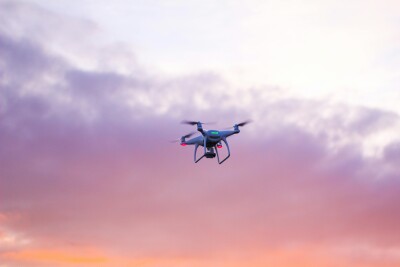Many have hailed Part 107 as the ruling from the FAA that the commercial drone industry as a whole has been wanting and needing for a long time. Plenty throughout the industry have been effusive in their praise around the ruling since it eliminates the cumbersome requirements that were associated with securing a Section 333 Exemption. Few can argue that Part 107 has opened up the sky for commercial drone operations in a real and positive way.
That said, Part 107 does not enable certain operations which many see as the key to making the technology viable for enterprises. Those include being able to operate beyond visual line of sight (BVLOS), over people and at night. During the “Out of Sight on Your Mind? Flying BVLOS, At Night and Over People” session at Drone World Expo, a panel of experts discussed what those limitations mean for commercial operators today and how they’ll impact the way the industry as a whole moves forward. Moderated by Mark Bathrick, Director, Office of Aviation Services at the US Department of the Interior, the session featured a lively discussion from experts in various corners from the industry around what it means to move forward in this new regulatory landscape. Michael Cohen, Executive Director at SkyBEAM, Andrew Krawczel, Aviation Services Manager at San Diego Gas & Electric and Michael Chambliss, Technologist at the International Cinematography Guild /IATSE Local 600 took the stage to talk through all of these issues and plenty more.Being able to operate BVLOS was a topic that came up in many different contexts throughout the session, and details around how that sort of operation represented an increase in risk and cost is something that was discussed in detail. Operating BVLOS brings up questions and concerns about privacy, but as Cohen noted, it’s probably the most significant issue that really isn’t a big deal. Drones have the ability to take pictures of people’s homes when they’re flying over or near them, but so do satellites. It’s an issue that needs to be addressed, but it’s also an issue that’s been around for a long while, even though few realized it until now.Krawczel mentioned one of the biggest and most important things San Diego Gas & Electric does around this issue is to get out in front of it as quickly as they can. Their team works to make info about what they’re doing with drones as readily available as possible. They approach it in terms of a public awareness campaign, and it’s been successful in raising awareness around the fact that these tools are not being used to spy on anyone.Perhaps the most illuminating quote of the session belonged to Bathrick, who mentioned that today’s airspace has been designed for yesterday’s aircraft and applications. While it’s clear officials in the FAA are working to make sense of how drones can be part of the airspace, they’re having to do so based on rules and platforms that have entirely different needs and requirements. This approach creates complications that various individuals, organizations and agencies continue to sort through.As you might expect, how a UAS traffic management (UTM) system factors into operating BVLOS came up, and the top two issues the panel mentioned around it concerned who was going to pay for this system, and what sort of protocols were going to work for it. These issues and plenty others have to clear some serious hurdles before a UTM system is going to be a viable option, and while progress is being made, the fourth level of technical capability NASA is proposing isn’t set to take place until 2019. Still, announcements like the one from AT&T and NASA around their research collaboration into traffic management solutions for UAS is proof that it’s impossible to know what we’ll see around this technology, or when we’ll see it.Discussions around safety and night time flying also provided some key insights in regards to what these topics mean to the individuals and organizations who need to consider them, but the Jeopardy!-style chart (see below) that Bathrick pulled up to get the audience to engage in a Q&A showed just how many different areas we’re dealing with. Some of the topics from the list had already been addressed, but it would have been especially interesting to further explore questions like OSHA vs FAA and notification overload.We’ll look to explore some of those topics in the next few months, but let us know via email or Twitter which ones you find to be the most relevant.
Moderated by Mark Bathrick, Director, Office of Aviation Services at the US Department of the Interior, the session featured a lively discussion from experts in various corners from the industry around what it means to move forward in this new regulatory landscape. Michael Cohen, Executive Director at SkyBEAM, Andrew Krawczel, Aviation Services Manager at San Diego Gas & Electric and Michael Chambliss, Technologist at the International Cinematography Guild /IATSE Local 600 took the stage to talk through all of these issues and plenty more.Being able to operate BVLOS was a topic that came up in many different contexts throughout the session, and details around how that sort of operation represented an increase in risk and cost is something that was discussed in detail. Operating BVLOS brings up questions and concerns about privacy, but as Cohen noted, it’s probably the most significant issue that really isn’t a big deal. Drones have the ability to take pictures of people’s homes when they’re flying over or near them, but so do satellites. It’s an issue that needs to be addressed, but it’s also an issue that’s been around for a long while, even though few realized it until now.Krawczel mentioned one of the biggest and most important things San Diego Gas & Electric does around this issue is to get out in front of it as quickly as they can. Their team works to make info about what they’re doing with drones as readily available as possible. They approach it in terms of a public awareness campaign, and it’s been successful in raising awareness around the fact that these tools are not being used to spy on anyone.Perhaps the most illuminating quote of the session belonged to Bathrick, who mentioned that today’s airspace has been designed for yesterday’s aircraft and applications. While it’s clear officials in the FAA are working to make sense of how drones can be part of the airspace, they’re having to do so based on rules and platforms that have entirely different needs and requirements. This approach creates complications that various individuals, organizations and agencies continue to sort through.As you might expect, how a UAS traffic management (UTM) system factors into operating BVLOS came up, and the top two issues the panel mentioned around it concerned who was going to pay for this system, and what sort of protocols were going to work for it. These issues and plenty others have to clear some serious hurdles before a UTM system is going to be a viable option, and while progress is being made, the fourth level of technical capability NASA is proposing isn’t set to take place until 2019. Still, announcements like the one from AT&T and NASA around their research collaboration into traffic management solutions for UAS is proof that it’s impossible to know what we’ll see around this technology, or when we’ll see it.Discussions around safety and night time flying also provided some key insights in regards to what these topics mean to the individuals and organizations who need to consider them, but the Jeopardy!-style chart (see below) that Bathrick pulled up to get the audience to engage in a Q&A showed just how many different areas we’re dealing with. Some of the topics from the list had already been addressed, but it would have been especially interesting to further explore questions like OSHA vs FAA and notification overload.We’ll look to explore some of those topics in the next few months, but let us know via email or Twitter which ones you find to be the most relevant.
















Comments